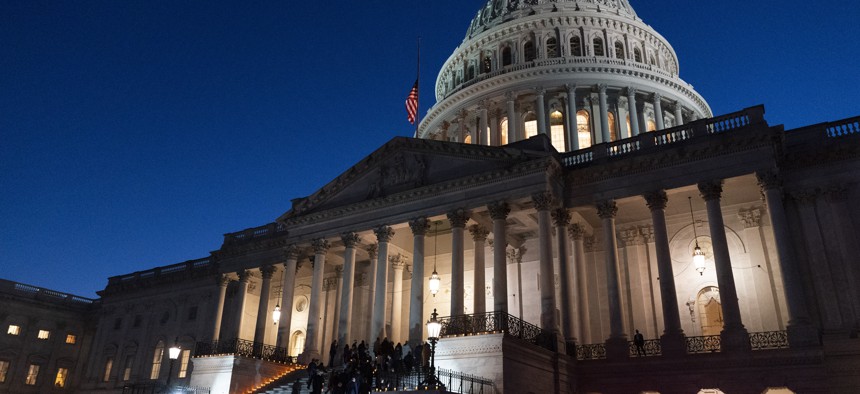House Passes $1.9 Trillion Covid Response Bill

A bipartisan group of members of the House and Senate, walk back up the steps of the Capitol after holding a moment of silence for 500,000 U.S. COVID-19 deaths, Tuesday, Feb. 23, 2021, in Washington. AP Photo/Jacquelyn Martin
The legislation includes $350 billion in direct aid for state, local, and tribal and territorial governments.
The House early Saturday passed President Biden’s $1.9 trillion coronavirus relief plan, which would provide $195 billion in direct aid to states and $130 billion to cities and counties across the United States.
While state and local leaders from across the political spectrum have pushed for passage of the bill, it passed on a largely party line vote, 219 to 212, with no Republicans voting for it and only two Democrats—Reps. Jared Golden of Maine and Kurt Schrader of Oregon—voting in opposition. The bill now goes to the Senate.
Local government groups applauded the measure's passage.
“American cities will be safer, stronger, and healthier because of this legislation," U.S. Conference of Mayors president and Louisville, Kentucky Mayor Greg Fischer said.
Republicans, have advocated for a much smaller $618 billion plan, and have criticized “liberal wish-list items” included in the House bill and said the amount it would provide states and localities surpasses their needs given the better than expected revenue outlook in some states.
"The Democrat plan rewards their friends and political allies and sends billions to states that have boarded up main street, closed schools, and left kids and parents in their communities struggling," Missouri Rep. Jason Smith, the top Republican on the House Budget Committee, said in a statement.
The version of the bill the House approved includes a federal minimum wage increase. But the Senate parliamentarian determined this week that chamber rules would not allow the $15-an-hour minimum wage provision to be included in the legislation.
House Speaker Nancy Pelosi said House Democrats opted to keep the provision in the bill, despite the dim outlook for it, because they “believe that the minimum wage hike is necessary.”
Under the House bill, each state would receive at least $500 million, with funding beyond that amount tied to unemployment levels.
Cities and counties would each draw from separate $65 billion pots of money, with cities relying on a modified Community Development Block Grant formula for distribution. Awards to counties would be based on population.
Earlier federal relief packages did provide $139 billion in direct aid for state and local governments, as well as billions of dollars for related areas like schools and transit. But many smaller and mid-sized localities did not receive direct funding from those measures. And state and local officials have also complained about the lack of flexibility with the previous funding.
"This bill recognizes counties’ vast responsibilities to care for our most vulnerable residents," Matthew Chase, executive director of the National Association of Counties, said of the newly passed legislation.
"After a year of this crisis, far too many counties have received no, or very limited, direct fiscal relief," he added.
The picture for state revenues was mixed last year. While some states saw revenue increases, 28 states reported declines in overall tax collections and seven reported percentage drops in the double-digits, according to the Tax Policy Center.
Total state tax revenues fell by 1.8% from April to December 2020 compared to the same period in 2019. On top of lower than expected revenues in many cases, states and local governments are also dealing with unanticipated expenses due to the pandemic.
“Our costs have skyrocketed, we have dug into our reserves and made difficult decisions to reduce our workforce," said NACo's Chase.
In addition to providing direct aid to governments, the House bill would also send $1,400 stimulus checks to Americans making $75,000 or less, provide $400-per-week supplemental unemployment payments, and it includes $130 billion to assist schools in reopening or facilitating remote learning.
Among the billions of dollars allocated in the bill for public health, $46 billion would fund Covid-19 testing, contact tracing and mitigation efforts; $7.5 billion would be spent on vaccine distribution efforts; and $7.6 billion would go toward expanding the public health workforce.
Maya MacGuineas, president of the nonpartisan Committee for a Responsible Federal Budget, said that while the House bill contains provisions to address pressing concerns—like expanding vaccinations, reopening schools and extending expiring unemployment benefits—it could be refined to be better targeted.
She specifically noted that many state and local budgets aren't as bad off as projections last year initially estimated they would be and that the $1,400 stimulus checks would go to many households that the pandemic hasn't hurt financially.
"We shouldn’t be afraid to 'go big' or borrow what’s needed," MacGuineas said. "But going big doesn’t excuse borrowing that won’t actually help fight the virus or boost the economy. Adding to the deficit still comes with risk and should be done judiciously."
This story has been updated.
Andrea Noble is a staff correspondent with Route Fifty.
NEXT STORY: Equity Budgeting in Cities: Directing Dollars Where They’re Needed Most





